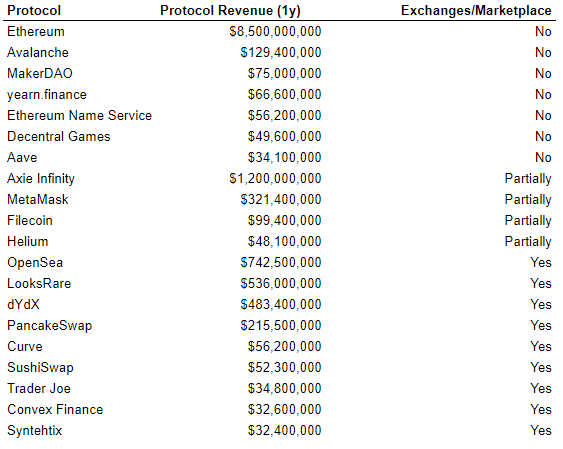Unsustainable Crypto Business Models
Yea the tech is cool, but should you build a business around it?
Disclaimer, NFA, all that legal stuff: All the information presented on this publication and its affiliates is strictly for educational purposes only. It should not be construed or taken as financial, legal, investment, or any other form of advice.
Hi folks,
The crypto market in the past week has been somewhat crabby although ETH created massive FOMO by going up ~50% in one week. They say the merge narrative aligns with the price movement but who knows what our macro gods will decide. On a completely unrelated note, we’re planning to launch a separate weekly quick bite issue in the next few weeks to provide more value for our readers—thank you once again for being my early supporters. The details are yet to be finalized, but we’ll be covering important charts of the week and presenting strategic ideas for protocols & DAOs.
My goal stays the same: to make this publication the most unique, informational, yet measured information source in crypto while serving as a platform for my brain dump. If you would like to converse in real-time or bounce ideas, feel free to connect with me on Twitter.
Unsustainable Crypto Business Models
In an UpOnly market, market participants tend to not care as much about the sustainability and defensibility of a company’s business model. New methods to assess a company’s valuation and moonshot narratives were brilliantly concocted to justify the price growth. No one wants to be the party pooper.
When the price continues to go up and to the right, browser-based virtual world online games with shitty graphics are dubbed as the next generation of gaming that enables users to own a part of the game, with virtual real estate plots selling for millions. Play-to-Earn often flawed mechanism design is deemed as the future of gaming and work, with radical proponents of the concept arguing that gamers will eventually prioritize the earn component, instead of focusing on building an awesome gameplay experience first.
New DeFi primitives that improve market efficiency by reducing end-users fees and protecting them from MEV arbitrageurs are seen as innovative ideas that deserve 9 figures valuation. Don’t get me wrong, these are cool features that certainly came out of months (or even years) of research work, but perhaps it does not justify the valuation given the underlying business models.
When the price goes down, even the most avid supporters and community members would start questioning how these protocols actually make money, and whether their business models actually make sense. In this write-up, we present some thinking on how crypto protocols can explore ways to sustainably make money. Remember, is it a good product, or is it just a public good?
Here are the quick takeaways:
Founders need to expand their business acumen and learn about non-crypto businesses.
Understand which business model is a race to the bottom and which is sustainable in the long term.
There are hard-to-solve important problems that require deep research work, which might never become good businesses.
The open-sourced, fork-able, and decentralized nature of crypto makes it challenging to predicate your business model on a mechanism that’s copiable.
Selling tokens for revenue might be controversial, but it is one of the current working models.
Is a Protocol a Business?
First of all, is a protocol a business? — No matter what you think about this (I wrote an entire piece about it), the reality is that these crypto projects have founders and team members that need to pay rent. While VC money might be able to subsidize the lifestyle of a 21-year-old crypto founder that rented out a yacht party as a means of “networking” for a few years, these projects need to eventually make money themselves in order to survive (not even thrive), especially as the macroeconomy enters a period of contraction. And oh, the yacht thing is a true story.


I have long touted that the notion of decentralization and the need to generate revenue are somewhat on the opposite spectrum of each other. It is not easy to maintain a good level of decentralization while also operating in an effective manner to maximize profit. The argument usually falls back to the decentralization ethos and doesn’t actually make a lot of business sense, especially if you decentralize way too early in the process. A much more mature protocol/network can certainly do so once it achieves a certain level of adoption — hitting the right balance between knowing when to pivot to a more decentralized structure and when to maximize for growth is critical.


Growing Your Business Acumen
People on Twitter like to mock management consultants such as McKinsey because they charge an exorbitant amount of money to write reports and recommend strategies without taking any real accountabilities. While it might be true that consultants are not the best operators, these folks generally have good business acumen by learning about multiple different industries during their tenure.
The number one piece of advice (if I even deserve to give one in the first place), that I would give to aspiring crypto founders is to learn how non-crypto businesses work.
Highly educated individuals in developed countries often focus on service-first businesses, whether that be financial markets, consultancy, or software. In emerging markets, your misinformed old-school Asian parents would say that these are not “real” businesses because you can’t directly touch the goods you’re selling.
Snarkiness aside, the point is: crypto founders need to think more about how what they’re building will make money — unless you’re aware that you’re working for the betterment of the technology, or you’re savvy enough to convince VC to pay your rent while you satisfy your intellectual cravings.
There are, of course, hard-to-solve important problems in crypto that require deep research work. However, when you’re raising capital to solve these problems, there better be a path to profitability. This is admittedly more difficult in web 3.0 because the majority of protocols are open-sourced and forkable, removing the IP defensibility moat that most web 2.0 startups have. Founders are also at risk of experienced operators coming into the space with large fundings, and vertically integrating into the business that you’re building; remember Apple entering BNPL? — to make matter worse, there’s no anti-monopoly law in the blockchain realm.
Alas, all of the above resulted in a natural progression whereby we need to continuously experiment with new business models that will work for crypto. As a result, the majority of successful crypto firms that we’ve seen out there are marketplaces. These firms are selling shovels during a gold rush.
Rent-Seeking Business Model
Oh, the irony. Crypto is supposed to be the new innovative technology that removes centralization, gives power back to the people, and creates a more equitable playing field for all parties involved. But at the same time, the largest and most successful companies are exchanges/marketplaces which are successful because they implement rent-seeking business models. CEXs, DEXs, and NFT marketplaces are the juggernauts of the space, which rightfully prompted critiques to argue that crypto’s entire use case is predicated on speculation.
One quick note. We’re not discussing Bitcoin and Layer 1 assets in this context because those are either digital currencies or blockchain networks, which require an entirely different framework of thinking — which also does not necessarily constitute a business model. Bitcoin’s “business model” is its narrative as a replacement for gold. L1 assets “business model” is gas fees and adoption.

Out of the 20 protocols listed above, 9 are considered marketplaces, and 7 are considered partially.
Excluding Ethereum, the majority of protocols revenue generated in the past year is coming from protocols with rent-seeking business models.
We get your point, so what are other ways we can start exploring new crypto business models?
Recurring Revenues
A recurring revenue model is one of the greatest business valuation multipliers for publicly traded equities in the past five years. Companies whose source of cash flow is primarily based on subscriptions not only create a more sustainable consumer cohort but also have a much more predictable future cash flow. This instills confidence in the investor class and builds long-term relationships with end consumers.

Let’s take a look at a few examples:
Amazon Prime
82% of US households have an Amazon Prime membership. As a result, Amazon can vertically integrate and be the dominant entity within these households. This ranges from Alexa smart speakers to Ring smart home tech, and now even One Medical. The firm has practically become the go-to marketplace for everything that you might need in your daily life.
Imagine you’re having a mild stroke (morbid, I know), you call for help via Alexa smart speakers, your Ring smart locks automatically unlock your front door, and a One Medical dispatch person quickly bolted into your house (this service doesn’t exist now, but let’s be creative shall we).
Apple One
825 million subscribers as of Q2 2022. That is $100B+. The world’s most affluent economic class is willing to pay a hundred billion dollars for a phone with a margin premium that’s equivalent to luxury brands.
However, the recurring revenue model has largely not been implemented in the crypto space due to technical limitations and the lack of product variety since the majority of profitable crypto companies are making money via marketplace-related fees, which is not necessarily fitting for a subscription model. Robinhood has tried with Robinhood Gold and Coinbase is currently trying with Coinbase One beta, but both are seeing lackluster responses from consumers.
That said, the building blocks are starting to emerge, and we are seeing more projects tackling different problems that will eventually enable a more seamless programmable cash flow, including subscriptions. Combined together, we can see how the following stacks will eventually give birth to killer decentralized applications that can integrate a subscription-based business model.
Sablier and Superfluid enable crypto payment streams.
Aave introduces Lens protocol, a decentralized social media stack.
Ethereum Naming Service provides clarity on web 3.0 identity.
Mirror introduces a web 3.0 subscriptions and notification system.
Web 3.0 messaging is being built.
Selling Tokens for Revenue
Just typing that headline title alone feels like a cardinal sin in the crypto space. The industry is extremely sensitive toward terms that might accidentally classify tokens as equities. That said, selling tokens and booking them as revenue for operational expenses is not that uncommon in the space. In fact, what used to be one of the top 3 largest crypto assets by market cap, XRP, has done this multiple times.
Fast forward to 2022, the model has shifted. A “sponsor” company built the protocol and owns a percentage of the token supply. With a proper design, the tokenomics of said protocol actually accrues value back to the token holders (usually some sort of fee-sharing mechanism), generating revenue for the protocol and the company in the process. The company then sells those tokens as revenues to continue its operation. With time and proper adoption, you can then sprinkle in spices of complexities by implementing a governance process or even a full-fledged DAO to manage the treasuries (and revenue) of said protocol, which is usually predominantly controlled by the original team members.
I don’t think this model is wrong per se, but it requires a lot of trust from the original team members before the protocol can reach a mature state and have a properly functioning DAO (is there even such a thing? ha. that’s for another post)
What’s the Big Idea?
During a bull market, it’s easy to sell big ideas wrapped in compelling narratives without meticulously considering the sustainability and defensibility of the business model. This happens with web 2.0 tech startups (Uber, anybody?) as well as crypto. In crypto, this can be further obfuscated because of the existence of tokens, which might create a false understanding of the projects’ actual health and money-making capabilities.
This is … a brave take by Tascha, although please give it more thoughts next time.
While builders and founders might be working on cool and innovative new technologies, it is important to be aware that crypto is open-sourced and you don’t have any real defensibility in terms of intellectual property. Understanding that first-hand will allow founders to carefully plan their strategy and be more thoughtful of the business that they plan to build. Don’t fall into the trap of building a public good if your goal is to make money.
As an industry, we need to do better and continuously brainstorm new concepts for projects to make money without resorting to predatory pseudo-ponzinomics machinations that depend on attracting new users and dumping them to generate revenue. I don’t claim to have all the answers, but the first step in solving a problem is to admit that there is one.
Shooting Yourself in the Foot
The firm I work for, Digital Asset Research, has entered into a strategic partnership with Cloudwall, the expert at digital asset risk, to offer portfolio risk management resources for institutional clients.
Promotional material aside, my first ever full-time job was at a crypto hedge fund during the last bear market in 2019. Long story short, the fund lost a significant amount of AUM and I knew that I needed to find another job. Ever since then, whenever I got a recruiter’s message about working at a fund, I always ask detailed questions about its AUM and risk management strategy. Experiencing that first-hand as a fresh graduate opened my eye to the importance of risk management and best practices when running a fund. Fast forward to 2022, no one would’ve predicted that 3AC will shoot themselves in the foot. “The essence of investment management is the management of risks, not the management of returns.” - Benjamin Graham
P.S. A few months ago, @thedefiedge reached out to me on Twitter and I’m now a contributor to his newsletter. We’re covering the latest trends, learnings, and frameworks in crypto in under 5 minutes every week.
Until next time,
Marco M.










Enjoyed reading this summary ser! Great questions asked! Wondering if there is any example of a revenue proven protocol yet; even Defi revenue is plunging as volume declined